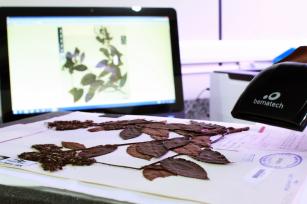Reference collections of plant genetic resources
Reference collections of plant genetic resources

Photo: Rosa, Ronaldo
Herbariums are scientific collections that keep samples of dried plants (exsicatas) from different ecosystems. The information contained in these places are basic sources for taxonomic, floristic, biogeographical, phenological and ecological studies, as well as providing data for the work on biodiversity, medicinal, toxic, fodder, food, among many others. In a simplified way, herbariums can be compared to archives, in which it is possible to collect diverse information about plants, such as habitat, general aspects of plant morphology, among others.
Herbariums and their subdivisions - collection of exsicatas, xiloteca (wood file), carpoteca (collection of fruits preserved for scientific purposes), material in alcohol, etc. - represent a fundamental part of biological research and the basis of botanical and conservation research.
The objective of Embrapa in maintaining herbariums is to guarantee the formation of a database as complete as possible about the diversity and vegetation of the different Brazilian biomes. The collections contain samples of important taxonomic groups of the Brazilian flora and, in addition, species associated to the conservation banks maintained throughout the country, including DNA samples.
It is also important to note that the species that are part of the herbariums constitute witness material to certify the scientific name of the species conserved.
This project includes collections of seven herbariums and two collections of DNA from Embrapa, in a total of 333,700 herbarium species and 129,000 conserved DNA samples. The objective is to enrich and maintain, in an organized way, the Reference Collections, based on the correct identification of accesses, maintenance of quality and availability of passport data, handling and characterization through the Alelo System to users. The aim is to modernize the collections and make them more accessible to the public, by making the data available in relational databases and through the internet.
Herbariums and their subdivisions - collection of exsicatas, xiloteca (wood file), carpoteca (collection of fruits preserved for scientific purposes), material in alcohol, etc. - represent a fundamental part of biological research and the basis of botanical and conservation research.
The objective of Embrapa in maintaining herbariums is to guarantee the formation of a database as complete as possible about the diversity and vegetation of the different Brazilian biomes. The collections contain samples of important taxonomic groups of the Brazilian flora and, in addition, species associated to the conservation banks maintained throughout the country, including DNA samples.
It is also important to note that the species that are part of the herbariums constitute witness material to certify the scientific name of the species conserved.
This project includes collections of seven herbariums and two collections of DNA from Embrapa, in a total of 333,700 herbarium species and 129,000 conserved DNA samples. The objective is to enrich and maintain, in an organized way, the Reference Collections, based on the correct identification of accesses, maintenance of quality and availability of passport data, handling and characterization through the Alelo System to users. The aim is to modernize the collections and make them more accessible to the public, by making the data available in relational databases and through the internet.
Status: Completed Start date: Fri Jan 01 00:00:00 GMT-03:00 2016 Conclusion date: Thu Dec 31 00:00:00 GMT-03:00 2020
Head Unit: Embrapa Genetic Resources & Biotechnology
Project leader: Taciana Barbosa Cavalcanti
Contact: taciana.cavalcanti@embrapa.br
Keywords: herbários, exsicatas, DNA, material-testemunho
